Britain’s coronavirus outbreak has plummeted to its lowest levels since September — before the second wave spiralled out of control, official data revealed today.
Department of Health bosses recorded 12,057 new infections, marking a 10.6 per cent drop from last Thursday. Another 454 deaths were also announced, a 33 per cent fall on last week.
Separate Public Health England figures revealed cases among school-age children have plunged to their lowest levels in five months. Around 86 cases were recorded per 100,000 10 to 19 year olds in the week ending February 14 — the lowest rate since September.
And in another sign the second wave is firmly in retreat, statistics showed Covid outbreaks shrunk in all but two local authorities in England last week. Only North East Lincolnshire and Tameside — out of 149 councils — saw a drop in infection rates.
The South East and South West also became the first regions to see their weekly infection rates drop below 100 cases per 100,000 since October.
Test and Trace data also revealed infections had plummeted by 30 per cent to their lowest levels since October. They recorded 106,474 new cases in the week to February 11, far below the more than 300,000 patients a week during the darkest days of January.
The encouraging fall in cases comes as Boris Johnson faces growing clamour for a speedier lifting of lockdown measures. The PM is set to unveil his ‘roadmap’ back to normality on Monday, with his ‘prudent’ approach set to make pubs and restaurants among the last places to reopen.
Business chiefs and politicians have demanded an accelerated timeframe to save firms from collapse, amid fears that restrictions might last for months, citing the success of the vaccine rollout and significant falls in deaths and infections. Even one of No10’s scientific advisers yesterday said the data was ‘pointing in the right direction’ for some brutal curbs on daily freedoms to be eased soon.
Despite swathes of data showing the worst of the second wave is now behind Britain, Sadiq Khan today called for ministers to reject calls for a swift easing of national curbs. London’s mayor urged the PM to ignore ‘shouting and hectoring’ from Conservative backbenchers as he prepares to unveil his exit roadmap.
However, there are hints that Britain’s outbreak may no longer be falling as quickly. A symptom-tracking app has even claimed infections are rising in parts of the UK. Any turn in the trend could be devastating now, with the Government inching closer to finally lifting lockdown for good. But doctors and scientists say they want infection and hospital numbers as close to zero as possible before draconian restrictions end.
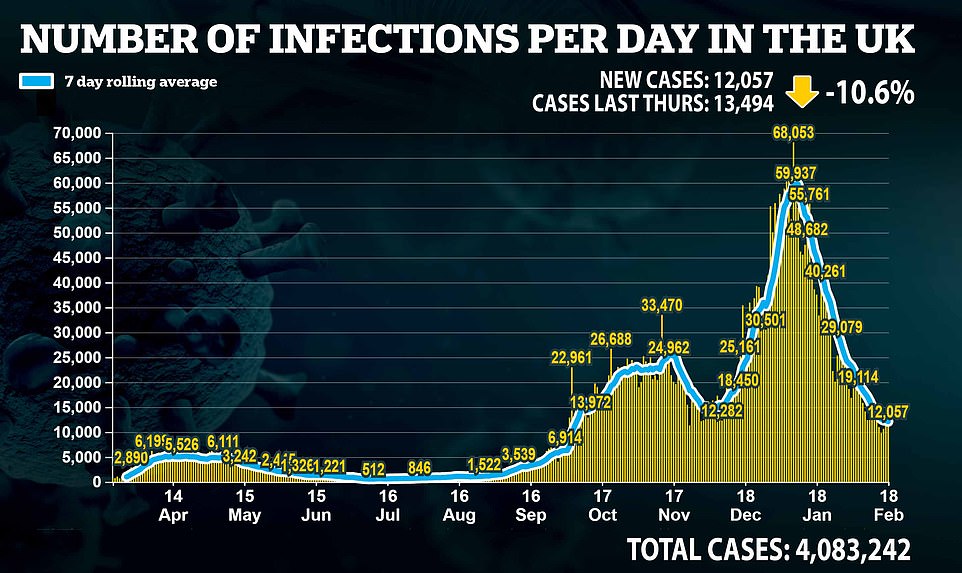

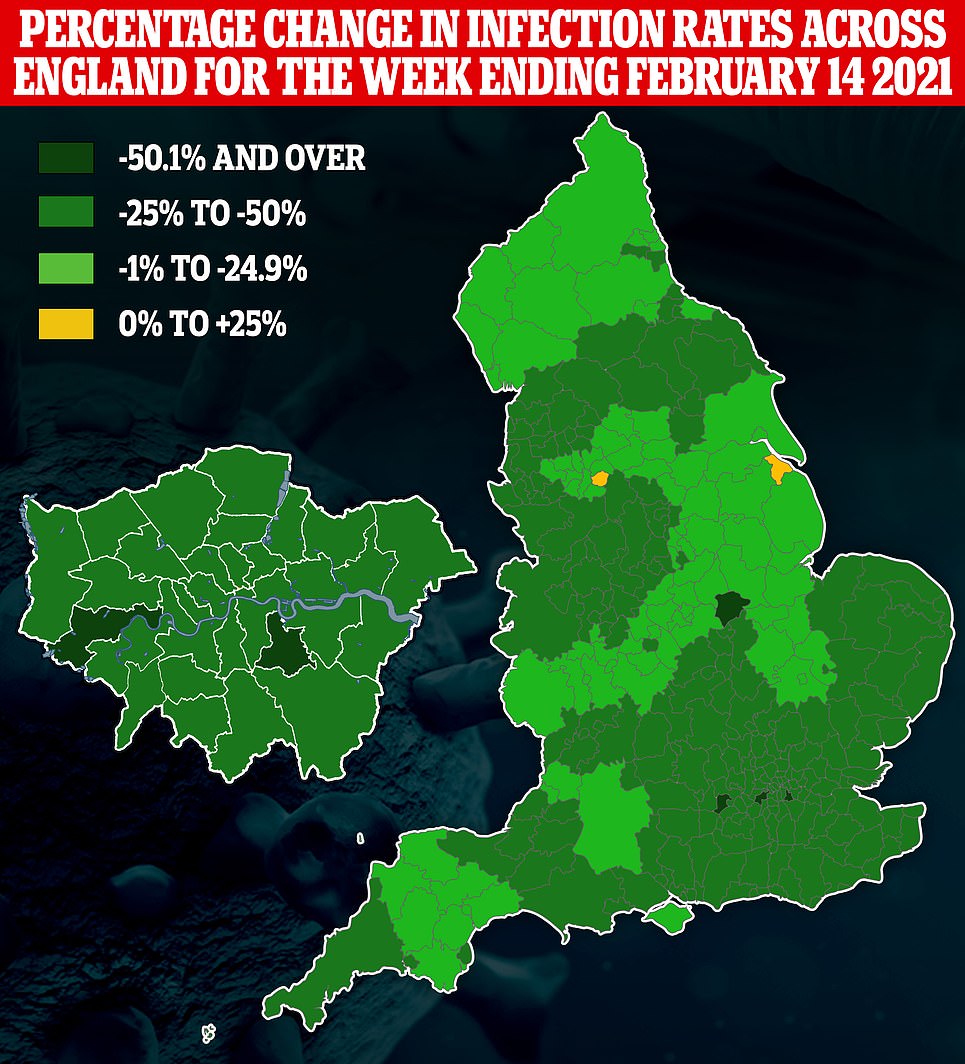
 ‹ Slide me ›
‹ Slide me ›
Only North East Lincolnshire and Tameside, in Greater Manchester, saw a rise in their coronavirus infection rate in second week of February (left). But the week before infections rose in six areas – Rutland, Calderdale, Middlesbrough, Bolton, North East Lincolnshire, and Hull (right)
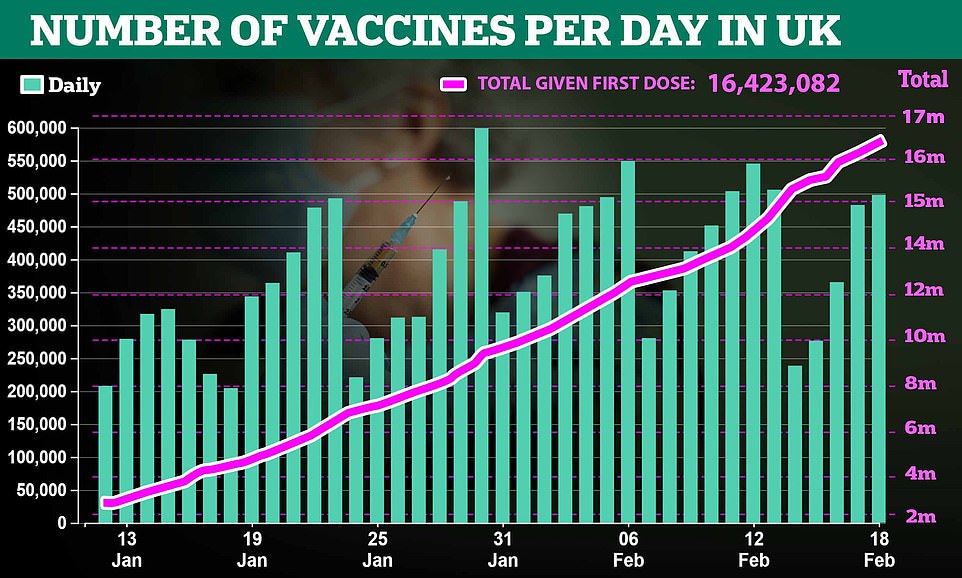

Covid cases plunged in all age groups in the second week of February. Among 10 to 19-year-olds they hit levels not seen since September, amid mounting calls for schools to be reopened
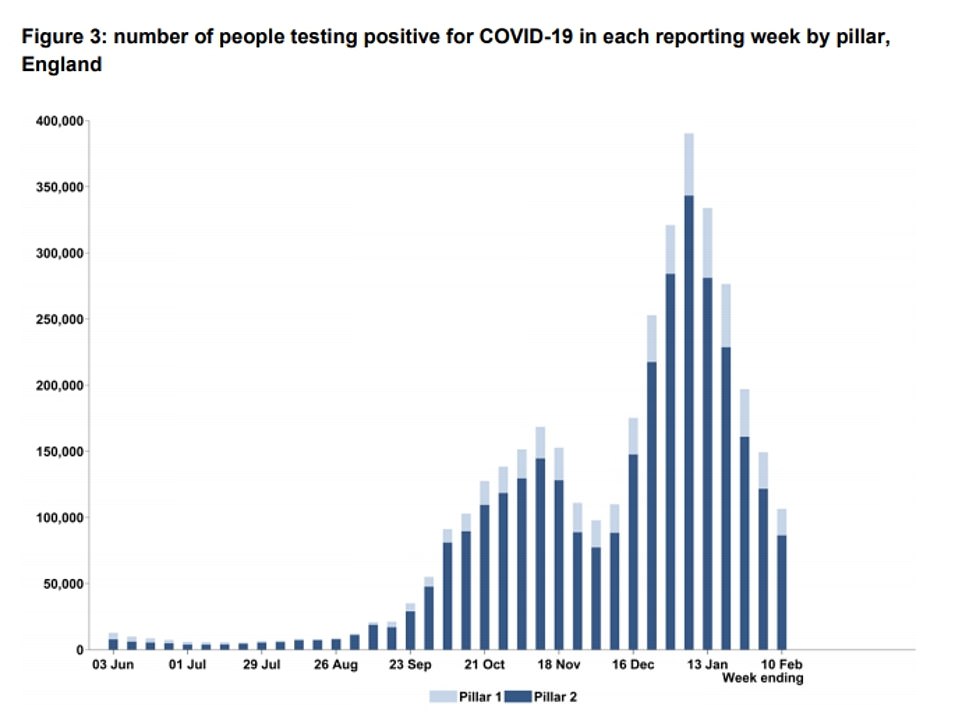
Test and Trace data shows there were 106,474 new cases identified in the week to February 10, at the same levels as in October as the brutal lockdown drives down cases
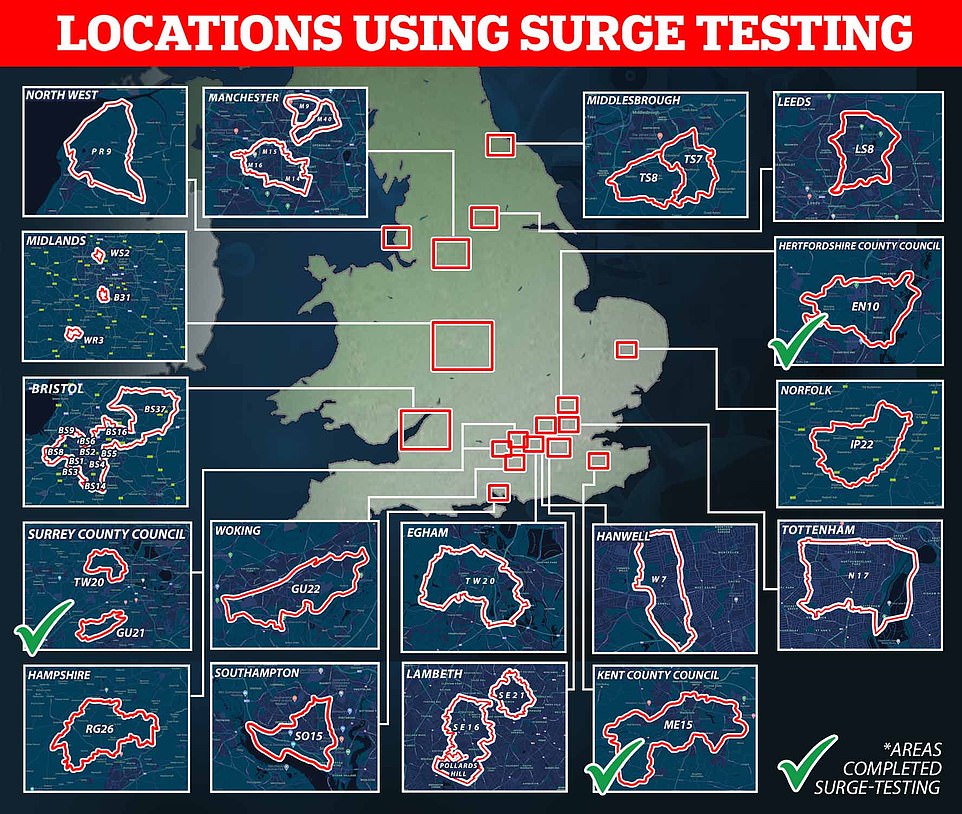
WHICH AREAS HAVE SEEN THE SHARPEST FALLS IN COVID INFECTIONS IN WEEK ENDING FEBRUARY 14
This data is from Public Health England (PHE) and compares the change in the infection rate per 100,000 people from February 14, the latest date available, to a week earlier.
Area
Rutland
Richmond upon Thames
Lewisham
Bracknell Forest
Havering
Croydon
Windsor and Maidenhead
Enfield
Greenwich
Southwark
% (infection rate)
-73.7% (122.72)
-52.7% (79.29)
-50.6% (77.49)
-50.2% (97.1)
-49.7% (95.16)
-49.6% (98.26)
-49.3% (73.31)
-49.1% (86.28)
-48.5% (88.21)
-48.1% (72.77)
Advertisement
In other developments today:
Angry pub bosses stormed out of a heated Government meeting after ministers accused them of leaking No10’s highly anticipated road map out of lockdown, sources claim;The coronavirus pandemic appears to be firmly in retreat around the world with every corner of the globe seeing infections fall except the Middle East, according to official figures;Finnish scientists claim to have found another Covid variant which shares some of the same mutations as other troublesome strains, including the South African and Kent versions;Companies demanding employees have a Covid vaccine before they are allowed to work might not be breaking the law with the demand, Justice Secretary Robert Buckland said;Britons could enjoy quarantine-free holidays in Greece this summer as the two countries discuss vaccine passports, with tourism minister saying ‘technical discussions are underway’; A British father-of-one tried to break out of a quarantine hotel near London Heathrow Airport this morning and has gone on hunger strike after claiming he is being held there ‘under duress’, MailOnline revealed;More than 20million years of life have been lost early due to Covid, with experts estimating that the disease shaved 16 years off the lives of every coronavirus victim, on average.
Public Health England’s data showed the infection rate among children aged 10 to 19 was at 86.2 per 100,000 in the second week of February, the latest available.
This is below every week since the seven-day spell ending September 26, when it was 53.4 per 100,000.
Covid cases also dropped in every age group and plunged by 38 per cent among the over-80s – who are most at risk of being hospitalised or dying if they catch the virus – to 129.6 per 100,000.
The infection rate was highest in 30 to 39-year-olds (192.5 per 100,000), followed by 20 to 29-year-olds (173.4 per 100,000) and 40 to 49-year-olds (162.9 per 100,000).
WHICH AREAS HAVE SEEN THE SHARPEST RISES IN COVID INFECTIONS IN WEEK ENDING FEBRUARY 14
This data is from Public Health England (PHE) and compares the change in the infection rate per 100,000 people from February 14, the latest date available, to a week earlier.
Area
North East Lincolnshire
Tameside
Donacaster
Rotherham
Bury
Darlington
Calderdale
Barnsley
Kingston upon Hull
Redcar and Cleveland
% (infection rate)
+119% (111.5)
+8.9% (195.15)
-0.3% (185.32)
-4.1% (213.25)
-4.7% (200.53)
-6.9% (189.13)
-9.2% (178.29)
-9.7% (172.97)
-10.1% (147.05)
-11.9% (189.57)
Advertisement
PHE data also showed the East Midlands was England’s Covid hotspot – the area with the highest number of infections – in the most recent week data is available after recording 176.7 per 100,000, but its cases still dipped by 23 per cent from the previous week. The South West had the lowest infection rate in England at 87.4 per cent, falling 30 per cent from the same time last week.
The infection rate only rose in two council areas: North East Lincolnshire, where they increased by 11.9 per cent to 111.6 cases per 100,000 residents, and Tameside in Greater Manchester, where they rose by 8.9 per cent to 195.2 per 100,000.
The sharpest drop in Covid infections was recorded in Rutland, which had been battling an outbreak in its prisons. Cases in the area plummeted by 73 per cent (122.7 per 100,000).
It was followed by the London boroughs of Richmond-upon-Thames where cases dropped by 52.7 per cent (79.3 per 100,000) and Lewisham where they fell by 50.6 per cent (77.5 per 100,000).
Bracknell Forest in Berkshire recorded the fourth biggest drop by 50.2 per cent (97.1 per 100,000), and Havering, also in London, saw the fifth highest by 49.7 per cent (95.2 per 100,000).
The smallest drops in Covid infections were recorded in Doncaster, South Yorkshire, where they only fell by 0.3 per cent (185.3 per 100,000).
It was followed by Rotherham, also in South Yorkshire, where they dropped by 4.1 per cent (213.3 per 100,000) and Bury, in Greater Manchester, where they dipped by 4.7 per cent (200.5 per 100,000).
In Darlington, County Durham, cases fell by 6.9 per cent (189.1 per 100,000) and in Calderdale, West Yorkshire, they fell by 9.2 per cent (178.3 per 100,000).
Public Health England’s report from the previous week revealed infections fell in 144 out of 149 local authorities – or 97 per cent – in the seven days to February 7. Rutland saw the largest increase at the time, followed by Calderdale, and Middlesbrough, North Yorkshire.
Separate data from Test and Trace data published today revealed infections had now plummeted to levels last seen in October.
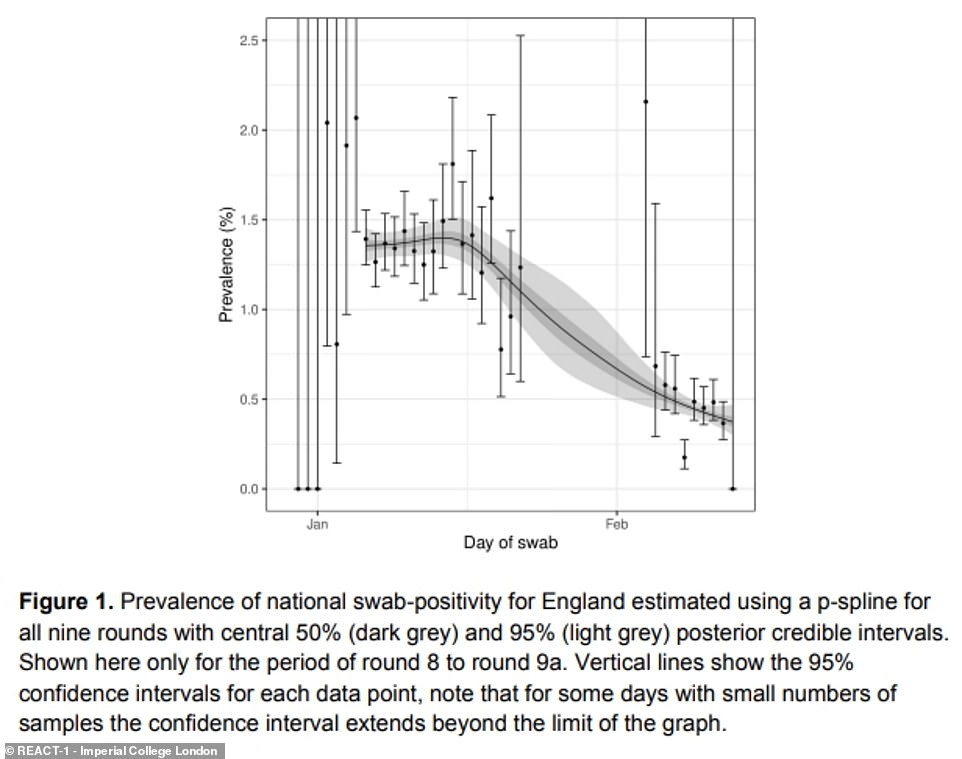
The country’s largest surveillance testing study has found just one in 196 people in England were infected with the virus during the first half of February, down from one in 64 the last time around, in January – the prevalence fell from 1.36 per cent to 0.44 per cent
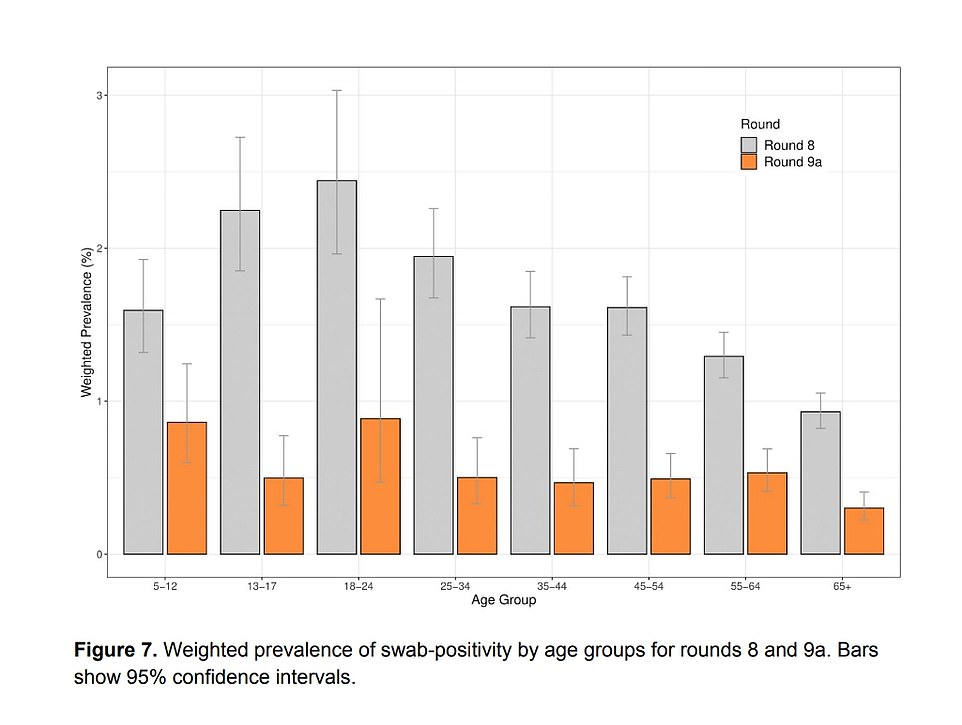
The data shows that prevalence fell across all age groups, but research now suggests the virus is now spreading the most among primary school children and young people. Experts warn that reopening schools would need to be done ‘carefully’ in light of the study data, which shows Covid is most prevalent among five- to twelve-year-olds and those aged 18 to 24

The R rate of the virus – the number of people infected by each person with coronavirus – is now at its lowest point in more than six months, the Imperial College estimates suggest, at 0.72, meaning the outbreak is shrinking
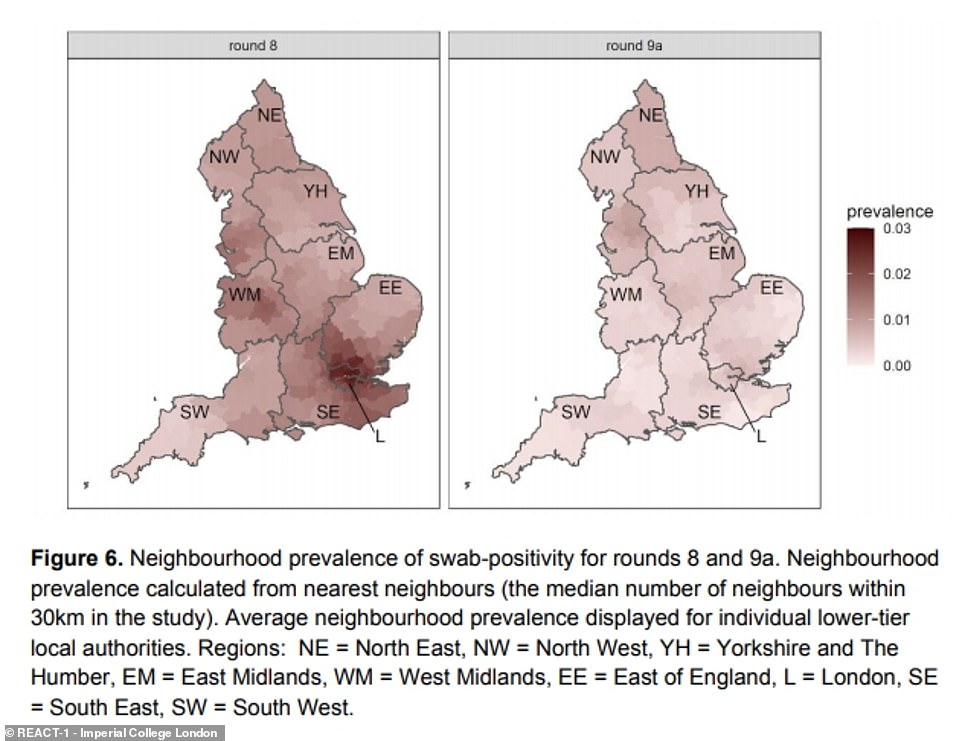
The proportion of people infected with the virus, also known as the prevalence, has come down in all regions of England in the past six weeks, the study found. Darker areas have more people testing positive for coronavirus – the map on the left represents mid-January, and the map on the right mid-February
SADIQ KHAN WANTS A LONGER LOCKDOWN
Sadiq Khan today risked the wrath of anti-lockdown Tory MPs and hospitality bosses as he demanded Boris Johnson reject calls for a swift easing of national curbs.
The Mayor of London urged the Prime Minister to ignore ‘shouting and hectoring’ from Conservative backbenchers as he prepares to unveil his exit roadmap on Monday.
Mr Khan said Mr Johnson must ‘learn the lessons of the mistakes made in the past’ when the Government has previously eased lockdown.
Mr Johnson has said his roadmap will be ‘based firmly on a cautious and prudent approach’ to ease restrictions in ‘such a way as to be irreversible’.
But many Tory MPs are adamant that the success of the nation’s vaccination drive should allow the PM to lift rules quickly.
Mr Khan’s intervention came after Mark Woolhouse, an Edinburgh University expert in infectious disease, said the latest data suggested there could be an ‘earlier unlocking’.
Meanwhile, an Imperial College London surveillance study – the largest in the country – found infection rates are halving every two weeks, with cases set to fall to 1,000 a day by the second week of April.
Advertisement
They also showed the number of people getting swabs for the virus remained high compared to the week before, suggesting there was a fall in infections. Almost 3million people got tested for the virus at least once, which was a drop of 4 per cent on the previous week.
Additionally, contact tracers identified 191,242 close contacts of those who had the virus — which had been near infected individuals for 15 minutes or more —, 27 per cent fewer than the previous week. Of these 93.6 per cent were reached by tracers and asked to self-isolate, helping to curb the spread of the disease.
The time taken to turnaround tests done at sites increased slightly, however, compared to the previous week. Eighty-five per cent got results in 24 hours, lower than the 86.3 per cent the week before.
The turnaround time for home testing kits also increased, from 34 hours to 35 hours. But the time taken to get results from satellite tests shrunk from 34 to 33 hours. Boris Johnson had previously promised that all Britons would receive their results within 24 hours.
And Department of Health bosses today said the average distance people travel for a Covid test is now under two miles.
Surge testing was also rolled out to Leeds today, with people in the LS8 postcode, including parts of Harehills and the area just north of Easterly Road where the SA variant variant was found, being ‘strongly encouraged’ to take a test when offered, whether or not they have symptoms.
Announcing the expansion of surge testing, a spokesman for the Department of Health said: ‘People living within this targeted area are strongly encouraged to take a Covid-19 test when offered, whether they are showing symptoms or not.
‘People with symptoms should book a test in the usual way, and those without symptoms should visit their local authority website for more information’.
They added: ‘Positive cases will be sequenced for genomic data to help understand Covid-19 variants and their spread within these areas.’
Earlier this week the department said targeted testing regimes would be set up in parts of Norfolk, Southampton and Woking in Surrey.
Efforts in Manchester to track down examples of the more transmissible Kent variant were also being expanded following deployment of testing teams last week.
It comes as figures today showed coronavirus infection rates have plummeted by more than two thirds since January, in proof that lockdown has worked even against the fast-spreading Kent variant of the virus.
The country’s largest surveillance testing study found just one in 196 people in England were infected with the virus during the first half of February, down from one in 64 the last time around, in January.
Results from the REACT study, led by Imperial College London and commissioned by the Government, revealed 0.51 per cent of the population had the virus between February 4 and February 13, down from 1.57 per cent.
The testing of 85,400 people during this time revealed the R rate – the average number of those infected by each person with the virus – was estimated to be 0.7, meaning the epidemic is shrinking. The figures revealed a ‘marked drop’ in prevalence compared to last month, and a ‘reassuring level of decline’.
The positive news will pile more pressure on Boris Johnson — who was last night facing a growing clamour for the speedier lifting of lockdown.
Amid fears that Covid restrictions might last for months, business chiefs and politicians demanded an accelerated timeframe to save firms from collapse. Also warning of the social cost of lockdown, they cited the vaccine roll-out success and significant falls in deaths and infections.
It comes after bosses from leading UK airlines today called on Boris Johnson to outline a recovery road map for the industry so they can plan for the summer, as passengers arriving from Spain and the US could be added to the ‘red list’.
The chief executives of British Airways, easyJet, Jet2.com, Loganair, Ryanair, Tui and Virgin Atlantic warned that the Government should provide a clear indication of intent that aviation will restart in the coming months.
They said that without this, the UK faces a year of limited global connectivity, and the economic recovery will be hindered. Airlines also called for more economic support to stimulate and strengthen any recovery when it comes.
The firms said the Prime Minister’s lockdown announcement next Monday should include a road map for airlines and consumers to help them plan for the summer and pave the way for the safe reopening of international travel.
UK health officials will decide this week if those arriving from the two countries should isolate for ten days in one of the 16 quarantine hotels approved by the Government in an effort to stop the mutant variants from spreading.
But daily Covid-19 case rates are falling in the US, down to a rolling seven-day average of 77,093 yesterday from 217,703 a month ago; and in Spain, down to 11,939 from 28,829. In the UK, they are down to 12,323 from 46,339.
Paul Charles, chief executive of travel consultancy The PC Agency, said the decision on whether to add Spain and the US to the ‘red list’ will depend on how the UK Government defines ‘high risk’ – in terms of variants or cases.
It comes as bosses from British Airways, easyJet, Jet2.com, Loganair, Ryanair, Tui and Virgin Atlantic today called on the Prime Minister to outline a recovery road map for the industry so they can plan for the summer.
The Cabinet Covid Operations Committee will make their decision using evidence from the Joint Biosecurity Centre. It comes after analysis carried out by the World Health Organisation found dozens of countries where the highly-infectious South African and Brazilian variants had been found were not on the Government’s high-risk list.
They included Austria, Denmark, France, Greece, Japan, Kenya, Norway, Sweden, Switzerland, Belgium, Canada and the US. Both Spain and the US have seen new mutations of Covid-19 transmitted locally and are close to South America and Portugal, which are both already on the UK Government’s ‘red list’.
Why IS Covid in retreat around the world? Global cases fell by 16% last week and have been in decline for over a month… even though experts say it’s too early for vaccines to be working
The coronavirus pandemic appears to be firmly in retreat around the world, with every corner of the globe seeing infections fall except the Middle East.
World Health Organization (WHO) figures show the number of new Covid cases fell by 16 per cent worldwide last week to 2.7million. It marks the fifth consecutive week infections have dropped after peaking at more than 5million in the week ending January 4. Covid deaths are also falling.
Infections plunged fastest in Africa and the Western Pacific (down 20 per cent), followed by Europe (18 per cent), the Americas (16 per cent) and South-East Asia (13 per cent). MailOnline’s analysis shows Myanmar was the nation that actually saw the biggest drop in cases, followed by Thailand and Sierra Leone.
The only WHO region to see Covid cases rise in the week up to February 14 was the Eastern Mediterranean, which mainly comprises of the Middle East, as well as parts of central Asia and North East Africa. Covid cases rose by 7 per cent there.
WHO director Dr Tedros Adhanom Ghebreyesus said the fact cases and deaths were falling globally highlighted ‘that simple public health measures work, even in the presence of variants’.
But experts are at odds as to why the key metrics are dropping universally around the world, despite immensely different lockdown tactics being deployed.
The roll-out of vaccines so far has been too patchy and not enough countries have access for the effects to be felt in the global data, according to Professor Simon Clarke, an infectious disease expert at Reading University. He told MailOnline seasonality ‘was likely to be at least partly responsible’ for the trend, adding: ‘This time last year I was sceptical about the seasonal link but I think it’s quite likely now.’
He said countries hit hard by the pandemic in the northern hemisphere, including in Europe and North America, are just emerging from the coldest months of winter, which could be slowing Covid’s spread. Many of the hardest-hit nations in Europe have also adopted tough lockdowns to combat second waves.
The virus, like so many respiratory infections, thrives as people spend more time indoors and are forced into close contact with others. Fresh, breezy air and warm temperatures, on the other hand, cut the risk of transmission.
Professor Clarke suggested countries in the southern hemisphere, including Brazil and Mexico, are in the middle of their summers, where the warm weather could be making Covid’s spread ‘quiet’. He added a clamp-down on international travel may also likely to be fuelling the global decline.

Experts are at odds as to why the metrics have risen and fallen at the same time around the world, despite immensely different lockdown tactics being deployed.
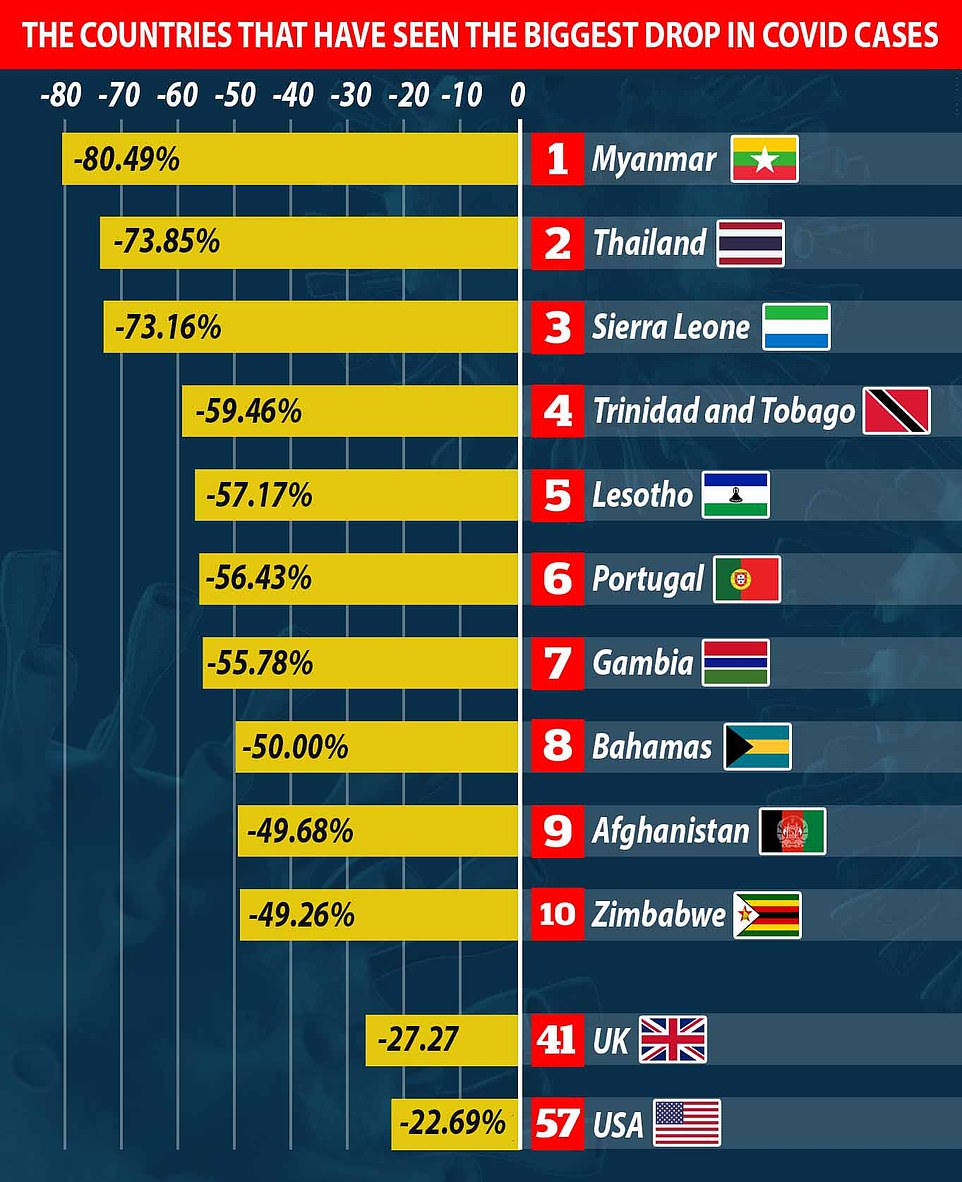
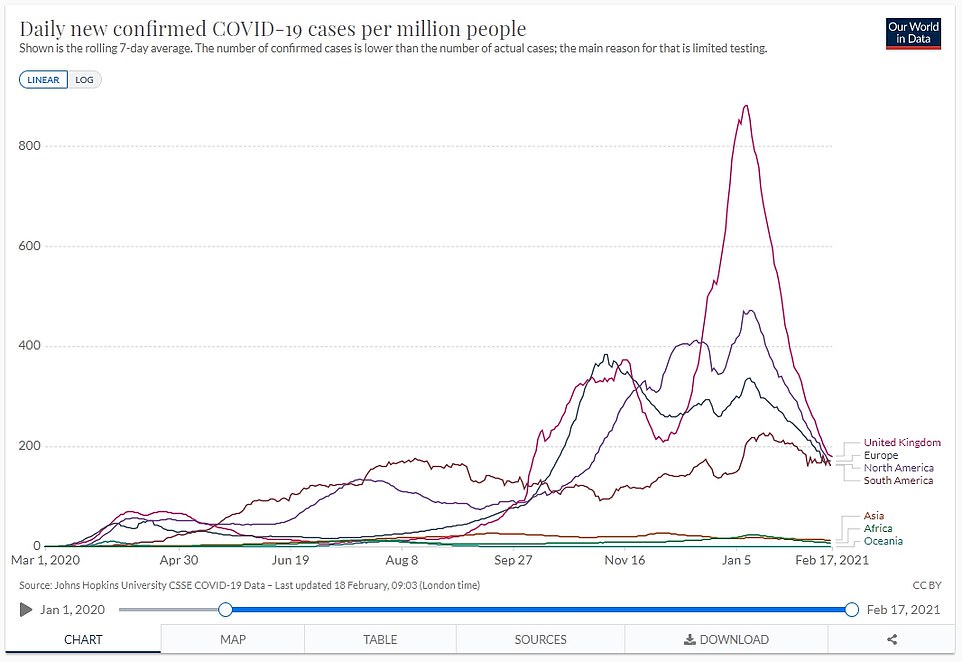
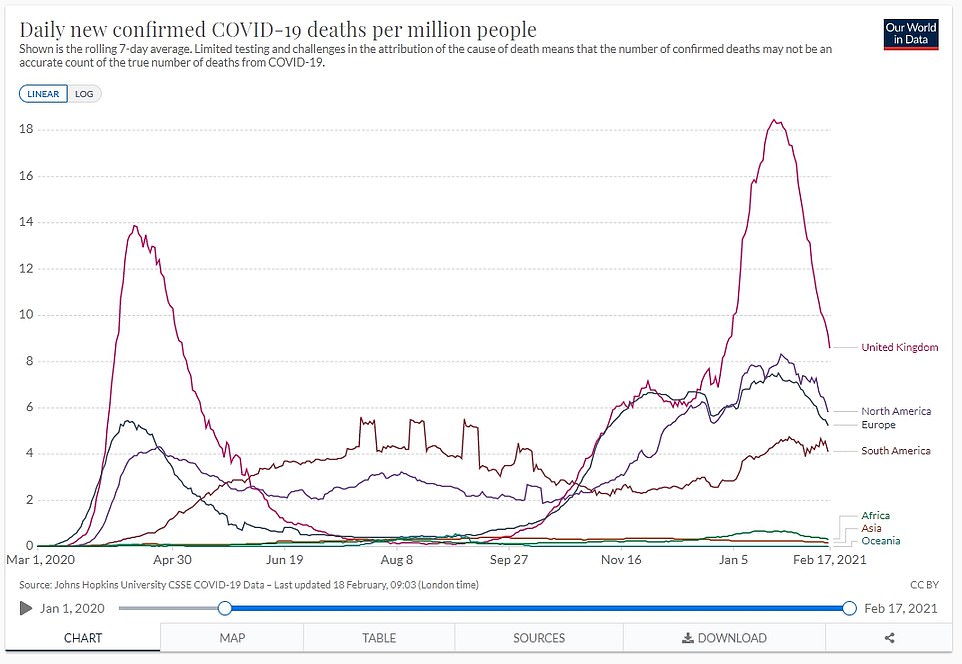
Revealed: The nations that have seen the biggest drop in confirmed Covid cases
COUNTRY
Myanmar
Thailand
Sierra Leone
Lesotho
Portugal
Gambia
Afghanistan
Zimbabwe
El Salvador
Eritrea
Burkina Faso
Sudan
Malawi
Eswatini
Spain
China
Suriname
French Polynesia
Monaco
Botswana
Colombia
Singapore
Japan
Comoros
South Africa
Uganda
Mozambique
Dom Republic
Kazakhstan
Tunisia
% DROP
-80.49%
-73.85%
-73.16%
-57.17%
-56.43%
-55.78%
-49.68%
-49.26%
-47.02%
-46.07%
-44.20%
-43.04%
-40.76%
-40.39%
-39.36%
-38.48%
-37.65%
-37.60%
-37.21%
-35.61%
-34.63%
-33.93%
-33.88%
-33.15%
-33.11%
-31.25%
-30.14%
-29.68%
-29.54%
-27.33%
CASES LAST WK
281
1,200
62
472
22,173
65
157
617
1,191
103
361
180
2,001
307
49,840
243
159
78
108
1,423
42,509
111
11,037
246
16,363
198
4,476
6,747
6,048
6,328
Source: World Health Organization figures on confirmed Covid cases in the week ending February 14, compared to the previous seven-day spell. It excludes nations that saw fewer than 50 cases over the week, such as Australia and New Zealand.
Advertisement
The promising figures signal that the entire world is emerging from the other side of the second wave, which in many countries surpassed the peak of the initial outbreak last year.
The second wave was fuelled by variants that were far more infectious and even deadlier than the original strain, which meant previously-effective lockdown measures worked less well.
The Kent strain, for example, which cropped up in South East England in late December and has spread to nearly 100 countries, is up to 70 per cent more transmissible and 30 per cent more lethal than the Covid which first emerged in China. Variants with similar mutations in South Africa and Brazil triggered an explosion of infections in their respective continents.
WHO’s latest report shows the total number of confirmed cases since the pandemic began is 108million. But poor testing capacity in developing nations means the true number will be higher and not everyone will suffer symptoms.
Figures show virus-related deaths dropped by double digits last week and were down in every part of the world, falling 10 per cent to 81,340. The latest update takes the pandemic death toll to nearly 2.4million.
The Kent variant — scientifically called B.1.1.7 — was reported in 94 countries in the week to Monday, the WHO’s latest report said, an increase of eight.
In half of those countries it’s thought to be spreading in the community, as opposed to the other nations where the cases are all believed to have been imported.
The strain first spotted in South Africa — known as B.1.351 — was recorded in 46 nations, up two, with community spread happening in at least 12 of them.
The Brazilian ‘P.1’ variant — which has yet to be spotted in Britain — was detected in 21 countries, up six, with human-to-human transmission occurring in at least two countries.
In its coronavirus updates, the WHO divides the world into six regions — Africa, the Americas, Europe, South-East Asia, the Western Pacific — which includes Oceania and neighbouring Asian countries such as Malaysia – and the Eastern Mediterranean region.
Broken down, Africa reported over 68,000 new infections from all strains and 2,500 deaths, according to the WHO’s latest update, a 20 and 21 per cent decrease, respectively, compared to the previous week.
This is the fourth consecutive week the continent reported decreases in both new cases and deaths. The highest numbers of new cases were reported in South Africa (16,363 new cases, or 27.6 per 100,000 population), Zambia (7,027 or 38.2 per 100,000) and Nigeria, (6,422, or 3.1 per 100,000).
The Americas recorded the highest number of cases and deaths in the most recent week, with 1.3million and 44,000, respectively.
In the most recent week, the US recorded again recorded the most infections in the region (673,630, or 203.5 per 100,000 population), followed by Brazil (318,290, 149.7 per 100,000) and Mexico (66,083, 51.3 per 100,000).
Across Europe there were more than 960,000 cases and 28,000 deaths, falling 18 and 19 per cent, respectively, when compared to the previous week.
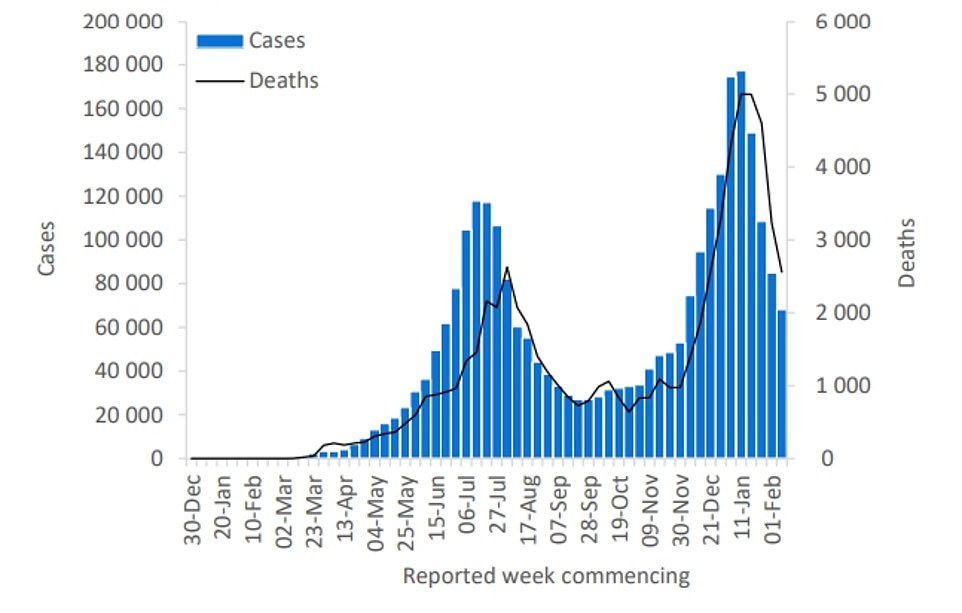
AFRICA: The continent reported over 68,000 new infections from all strain and 2,500 deaths, according to the WHO’s latest update, a 20 and 21 per cent decrease respectively compared to the previous week
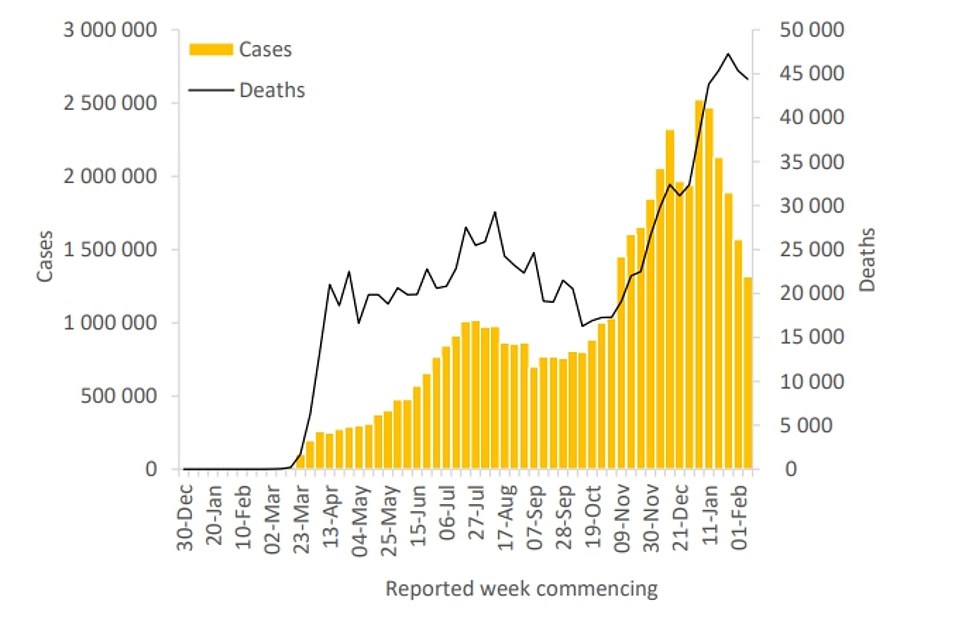
AMERICAS: The Americas recorded the highest number of cases and deaths in the most recent week, with 1.3million and 44,000, respectively
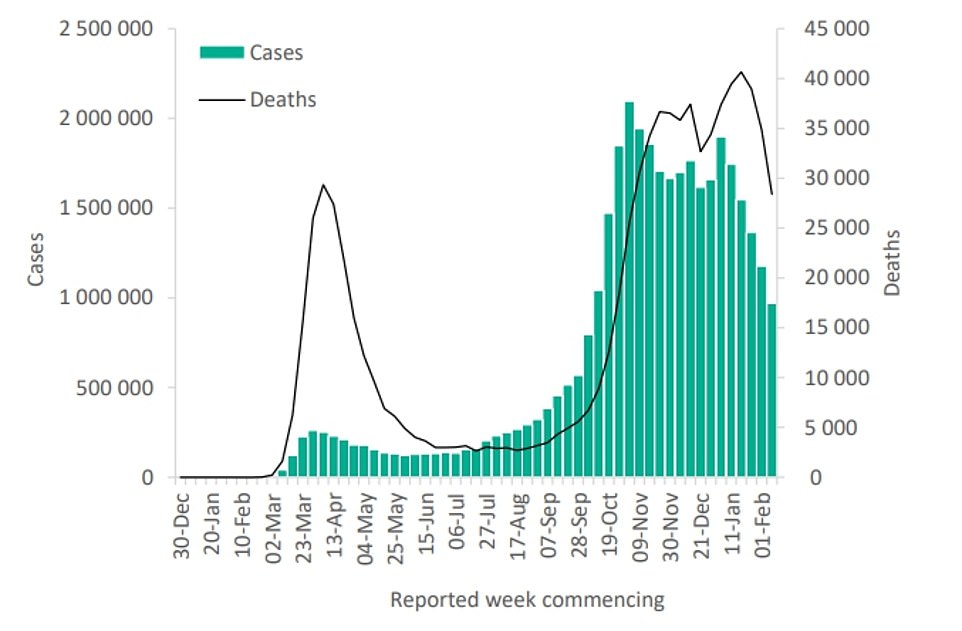
EUROPE: Across Europe there were more than 960,000 new cases and 28,000 deaths, falling 18 and 19 per cent when compared to the previous week

EASTERN MEDITERRANEAN: The Eastern Mediterranean region recorded more than 170,000 cases up to February 14, a 7 per cent increase compared to last week. The region reported just over 2,500 new deaths, a 9 per cent decrease
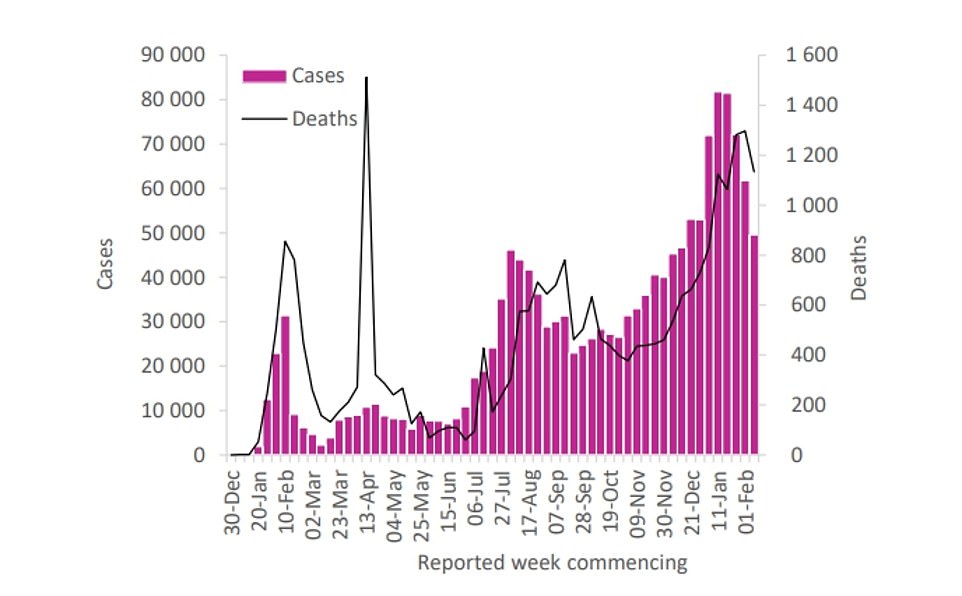
WESTERN PACIFIC: The region, which includes Australia and New Zealand, two counties to successfully pursue Covid-zero policies, saw the fewest number of people catch the virus over the past week

SOUTH-EAST ASIA: In South-East Asia over the past week, there were about 150,000 new cases, a decrease of 13 per cent compared to the previous seven days. The region reported over 2,300 new deaths, down 9 per cent
France (127,565, 195.4 per 100,000, Russia (104,602, 71.7 per 100,000), and the UK (97,271, 143.3 per 100,000) had the highest infection rates.
The Western Pacific region, home to Australia and New Zealand which successfully pursued Covid-zero policies, saw the fewest number of people catch the virus over the past week.
Just 49,000 cases were officially recorded in the seven-day period, 20 per cent lower than last week, and 1,100 deaths, a 13 per cent decrease.
The three countries reporting the highest numbers of new cases in the region this week were Malaysia (23,084 new cases, or 71.3 per 100 000, the Philippines (11,734, 10.7 per 100 000), and Japan (11,037, 8.7 new cases per 100,000).
In South-East Asia over the past week, there were about 150,000 new cases, a decrease of 13 per cent compared to the previous seven days. The region reported over 2,300 new deaths, down 9 per cent.
India (78,577 new case, or 5.7 per 100 000) had the highest number of infections, followed by Indonesia (63,693, or 23.3 per 100 000), and Sri Lanka (6,276, or 29.3 per 100 000).
The Eastern Mediterranean region recorded more than 170,000 cases up to February 14, a 7 per cent increase compared to last week. The region reported just over 2,500 new deaths, a 9 per cent decrease.
Iran (51,503 new cases, or 61.3 per 100 000), the United Arab Emirates (22,203, or 224.5 per 100 000) and Lebanon (19,156, or 280.7 per 100 000).
Do lockdowns really make a difference? How two US states with totally opposite Covid strategies both ended up with the same result
Since the early days of the coronavirus pandemic in the United States, no two states have been more different in their approaches than California and Florida.
In early March, California Gov Gavin Newsom limited gatherings, closed bars and indoor dining at restaurants, implemented mask mandates and implored residents to stay at home.
Comparatively, Florida Gov Ron DeSantis has enacted few measures, lifting an ordinance that prevented people from operating businesses and restaurants as well as lifting COVID-19 related fines and penalties in September.
Looser restrictions mean schools have not been shut down statewide and mask mandates have never been imposed.
In November, he even criticized states like California with harsher restrictions and said he trusted his residents to ‘use common sense.’
In an interview on Fox News Business on Sunday, DeSantis argued that Florida ‘focused on lifting people up’ during the pandemic but ‘lockdown states’ are ‘putting people out of business.’
‘There’s a whole bunch of things we’ve been doing for COVID, but at the same time, we’ve lifted our state up, we’ve saved our economy and I think we’re going to be first out of gate once we are able to put COVID behind the country,’ he told Sunday Morning Futures with Maria Bartiromo.


Over the course of the pandemic, California (left) has had a rate of about 8,499 COVID-19 cases per 100,000 residents while Florida has had about 8,306 (right) per 100,000. Currently, both are seing a rapid declines with fewer than 10,000 cases being reported every day. The dashed line represents the national seven-day average and the solid line represents California’s and Florida’s seven-day averages


Both California (left) and Florida (right) have been recording anywhere between 10 and 20 deaths per million people over the last two months. Historically, Florida has recorded about 130 cases per 100.000 people and in comparison with 117 deaths per 100,000 in California. The dashed line represents the national seven-day average and the solid line represents California’s and Florida’s seven-day averages


Both California (left) and Florida (right) have been recording anywhere between 10 and 20 deaths per million people over the last two months. Historically, Florida has recorded about 130 cases per 100.000 people and in comparison with 117 deaths per 100,000 in California. The dashed line represents the national seven-day average and the solid line represents California’s and Florida’s seven-day averages
Despite these different approaches, both states ended up with roughly the same outcome. A DailyMail.com analysis shows that, over the last two months, the states have each seen cases, deaths and hospitalizations fall by about one-third.
So were lockdowns necessary and did they work? The answer is a complicated one, but researchers say that they were beneficial in the early months due to our lack of knowledge about how COVID-19 spread and how to treat it.
Studies have shown that stay-at-home orders and restrictions saved numerous lives, but that they might be less useful now as more of the population gains natural immunity through infection or immunity via vaccination – but that social distancing and masks are still necessary to continue driving down case and death rates.
When looking at raw numbers, California appears to be doing worse than Florida.
The Golden State has 3,399,878 total cases and 46,843 total deaths – both figures are the highest in the nation.
By comparison, Florida is reporting 1,827,373 total infections and 28,779 fatalities.
However, population size must be taken into consideration. California has about 40 million residents and Florida has about 22 million.
When adjusted for this metric, the states have very similar case rates.
According to The COVID Tracking Project, California and Florida are both reporting an average of between 200 cases and 400 cases per million people, and each have been seen declines over the last several days.
Both states followed a similar curve with a spike in cases around January 1 – as the winter surge led to rapidly rising rates of cases and deaths – with infections starting to tail off a few weeks later.
Advertisement Why did COVID fail to take off in India and has now collapsed? Mystery plunge in coronavirus baffles experts
Scientists are trying to work out why coronavirus cases in India are falling when at one point it looked like the country might overtake the US as the worst-hit nation.
In September the country was reporting some 100,00 new cases per day, but that went into decline in October and is now sitting at around 10,000 per day – leaving experts struggling to explain why.
While the Indian government has been keen to put the apparent success down to its mask-wearing and social distancing laws, few believe these measures alone are responsible for the dip.
Instead, experts believe it may be down to the fact that India’s largest cities have reached herd immunity, meaning the virus has moved to rural areas where it spreads slower and where cases and deaths are far less likely to be tested and logged.
A recent survey found 56 per cent of people in Delhi – the country’s most-populous city – have Covid antibodies, which is likely to be an under-estimate with 70 per cent required for herd immunity.
Only around 20 per cent of deaths in India are medically certified – meaning 80 per cent do not have an official cause of death – with analysts warning the country may be under-counting its Covid fatalities by two or three times.
India also tests far less than developed nations, with medical experts warnings some states are relying on rapid lateral flow tests that give false-negative results.
The country also has a far younger population than many western nations – with an average age under 30 – and has far lower rates of obesity, which are both major factors in serious Covid infections and deaths.
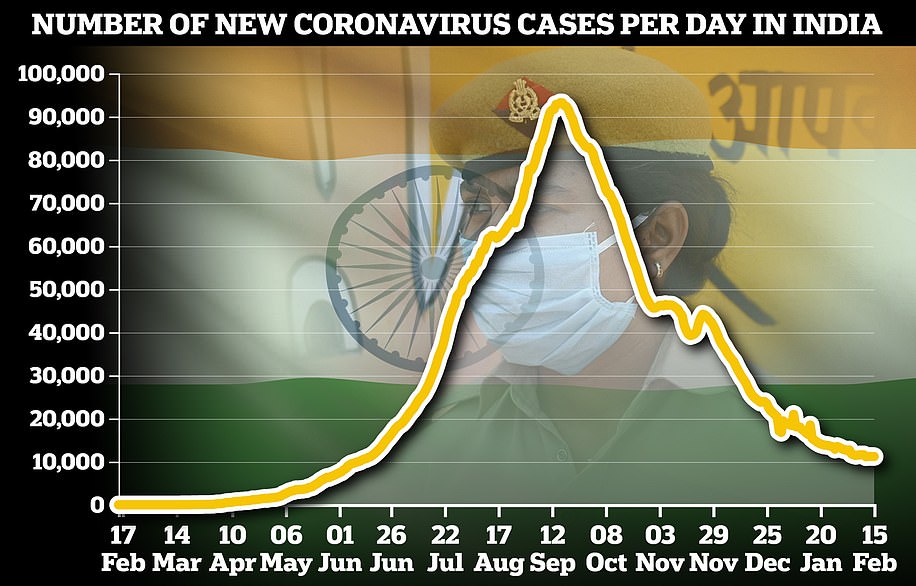

Antibody surveys carried out in Mumbai, India’s second-largest city, and Pune also showed antibodies in around 50 per cent of the population, The Times reported.
‘The most densely-populated areas are already saturated and reaching the threshold of herd immunity, Giridhar Babu, an epidemiologist at the Public Health Foundation of India, told the paper.
‘The virus has now spread to rural areas, but they are not so dense.’
Having a less-dense population means the virus spreads slower, which will naturally bring down daily case figures.
But with access to healthcare in rural India often lacking, it may also mean that many cases and deaths are going undetected.
Testing data for India shows that just 0.5 people per 1000 are swabbed each day – one of the lowest rates among countries that report such data.
More data released in September last year showed that people in rural areas are less-likely to be swabbed than those in cities – meaning that as the disease moves away from urban centres, the number of positive tests appears to decline.
The average number of tests carried out per day has also been falling across the whole of India since mid-December, which could also help to explain why positive test results have fallen.
And even those who are swabbed may be returning false-negative results, with doctors warning in September last year that many states are over-reliant on rapid lateral flow tests, which are unreliable.
Rijo John, a public health policy analyst, also warned that some states are failing to report which kind of tests are being used, further muddying the picture.
‘More and more states are moving towards rapid antigen detection tests, which are known to have a high percentage of false negatives and not utilising the gold standard RT-PCR tests to full capacity,’ he said.
‘It should be made mandatory for all states to report the break[down] of different test types as well as the positives from these.’
Data also shows 80 per cent of Indians die at home, with no national requirement for a cause of death to be given before a body can be cremated or buried.
That has led experts to warn of a ‘substantial’ under-counting of deaths, with Dr Babu warning the true toll could be two or three times higher than the official count.
Advertisement
Source link : https://www.dailymail.co.uk/news/article-9274623/Covid-outbreaks-shrunk-TWO-areas-England-Public-Health-England-report-reveals.html











